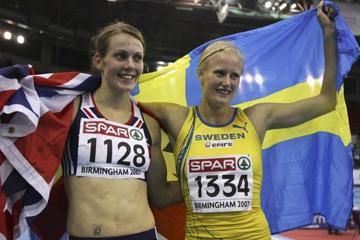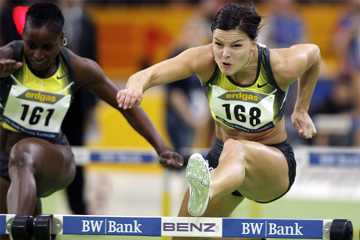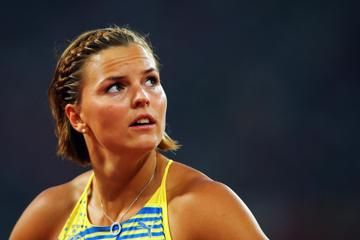Susanna Kallur after the 100m hurdles at the IAAF Diamond League meeting in Stockholm (© Getty Images)
It started with a stress fracture – a small, almost imperceptible crack in her right tibia – but soon things went from bad to worse for Susanna Kallur.
It was June 2012, two months out from the London 2012 Olympic Games, and her dream had turned into a living nightmare.
Kallur’s right shin, littered with fragments of screws from multiple surgeries, had a hole which refused to heal. At 31, the Swedish hurdling star was staring at an injury-induced retirement from the sport.
Against all odds, though, she’s back.
The 35-year-old returned to action at the IAAF Diamond League meeting in Stockholm on Thursday, her first competitive 100m hurdles race in six years.
Kallur was introduced to the crowd in a bright pink strip, and if the nervous look on her face was understandable, so too was the smile that replaced it as the Swedish fans offered her a thunderous reception.
“I’ve been longing every day the last six years to be back here,” said Kallur. “I’m pain-free now and it’s a feeling of freedom. It’s indescribable.”
She didn’t need to put words on it, for her actions spoke volumes.
When the gun fired, Kallur rocketed from the blocks, bringing back memories of the way she used to start, and matched 2016 world leader Kendra Harrison until the fifth hurdle before the American pulled away to win in 12.66.
Kallur clocked 13.00, but fifth place felt almost as good as first. The moment she crossed the line, the 35-year-old broke into an elated smile, and everyone understood why.
Assessing the options
After all, just being back on this stage had for so long seemed an impossible dream.
“The lowest point was in 2012 when they realised the hole in my bone was dead,” recalls Kallur. “They told me you have to put this long nail all the way through it or stop running, because this bone is never going to be good enough to run on.”
Her Olympic dream that year was shattered, maybe forever, so Kallur sat back to consider her options.
She had already won two European 60m hurdles titles indoors, one European 100m hurdles crown outdoors, and held the world indoor record for 60m hurdles.
It was a great career, and everyone would have understood if she chose to walk away.
But she couldn’t.
“It was a tough moment but I decided I was going to put that long thing through my bone, have a baby and then come back,” she reflected. “During all of these years, even though it’s been really heavy mentally, I’ve felt there is hope, that I have a small chance of making it back; that’s what’s kept me going.”
Kallur gave birth to her daughter Majken in June 2013, and since then it’s been a rocky, knife-edged ascent to regain her health and fitness, one which has sent her tumbling back to square one on several occasions.
“I had pins put in my shin and that didn’t work, so they took them all out,” she said “Then there were some broken screws inside the bone, so I had drilling to take those out and that left a big hole in the bone that never healed.”
The final resort was the long metal insert, and though Kallur speaks perfect English, she searches around and comes up short when trying to describe it.
“It looks like a flute inside my bone. But now, at least everything is in place.”
Cautious return
Kallur returned to the track in 2014 after a four-year absence, competing in three domestic 100m races, and got back hurdling at an indoor meeting the following spring, but soon her body betrayed her once again and she missed the rest of 2015.
This season, she has adopted a cautious approach, running 60m races indoors, without the barriers, to avoid the extreme demands that hurdling places on her body.
“I can’t just run like I did when I was 25. I’m careful. I hurdle a lot less now than I did before, but I’m hoping it will be enough to perform.”
Injuries may have blunted her speed, but they also helped her unearth a certain wisdom.
“I learned so much about myself. Before, I thought my main drive was the competitions, but now I’ve learned that I actually love training too.”
Becoming a mother has also helped her keep a healthy perspective that’s all-too-often missing in elite athletes.
“I guess my life is more balanced because I have the most important thing at home, but my passion for track and field is still the same.”
To qualify for the Olympics, Kallur will have to run inside the Swedish federation’s revised standard of 12.80, which looks a slightly daunting task. Then again, she’s overcome the most unlikely of odds just to get here.
“I’m going to go for it,” she says. “If I can come back from this, it’s going to be by far my biggest achievement, even bigger than the world record.”
And as someone who could write the book on overcoming injuries, what advice would she give to athletes in similar situations?
“As long as you feel like you want to keep going and there’s hope, I don’t feel you should listen to other people that are negative. If you want to do it, go ahead. It’s possible to do so much more than what most people think.”
The last few years have taught her that, and though she hasn’t been able to race, Kallur has followed the sport with an eagle eye, hoping and dreaming of a night like Thursday, once again being part of the show instead of sitting in the audience.
“I get mixed feelings watching but if I can’t hurdle myself then it’s good to watch great hurdling. I can feel it in my body when I watch someone else. I feel the rhythm.”
Having now found her own rhythm once more, Kallur has no intention to exit stage left. She’s given too much to this cause not to see it through.
“As long as I feel that there’s hope, then I don’t want to give it up. I love track and field. I can’t stay away.”
Cathal Dennehy for the IAAF















